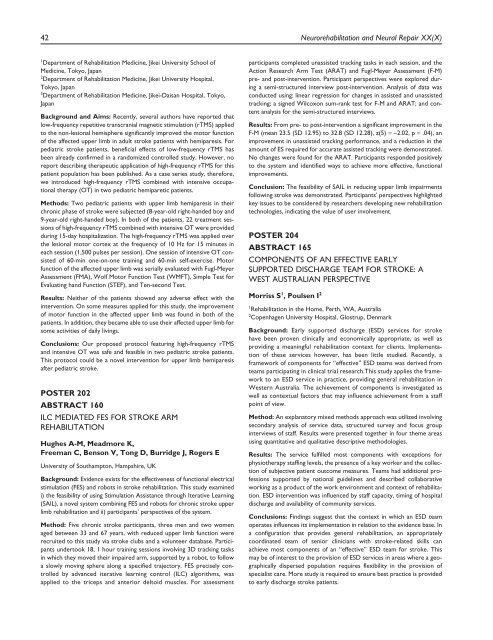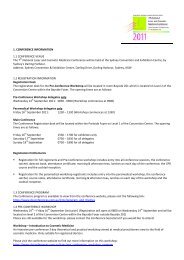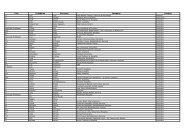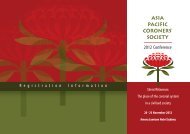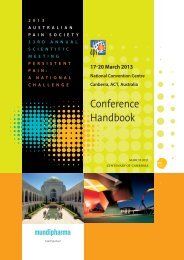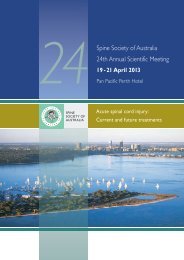WCNR 2012 Poster Abstracts - DC Conferences
WCNR 2012 Poster Abstracts - DC Conferences
WCNR 2012 Poster Abstracts - DC Conferences
You also want an ePaper? Increase the reach of your titles
YUMPU automatically turns print PDFs into web optimized ePapers that Google loves.
42 Neurorehabilitation and Neural Repair XX(X)1 Department of Rehabilitation Medicine, Jikei University School ofMedicine, Tokyo, Japan2 Department of Rehabilitation Medicine, Jikei University Hospital,Tokyo, Japan3 Department of Rehabilitation Medicine, Jikei-Daisan Hospital, Tokyo,JapanBackground and Aims: Recently, several authors have reported thatlow-frequency repetitive transcranial magnetic stimulation (rTMS) appliedto the non-lesional hemisphere significantly improved the motor functionof the affected upper limb in adult stroke patients with hemiparesis. Forpediatric stroke patients, beneficial effects of low-frequency rTMS hasbeen already confirmed in a randomized controlled study. However, noreport describing therapeutic application of high-frequency rTMS for thispatient population has been published. As a case series study, therefore,we introduced high-frequency rTMS combined with intensive occupationaltherapy (OT) in two pediatric hemiparetic patients.Methods: Two pediatric patients with upper limb hemiparesis in theirchronic phase of stroke were subjected (8-year-old right-handed boy and9-year-old right-handed boy). In both of the patients, 22 treatment sessionsof high-frequency rTMS combined with intensive OT were providedduring 15-day hospitalization. The high-frequency rTMS was applied overthe lesional motor cortex at the frequency of 10 Hz for 15 minutes ineach session (1,500 pulses per session). One session of intensive OT consistedof 60-min one-on-one training and 60-min self-exercise. Motorfunction of the affected upper limb was serially evaluated with Fugl-MeyerAssessment (FMA), Wolf Motor Function Test (WMFT), Simple Test forEvaluating hand Function (STEF), and Ten-second Test.Results: Neither of the patients showed any adverse effect with theintervention. On some measures applied for this study, the improvementof motor function in the affected upper limb was found in both of thepatients. In addition, they became able to use their affected upper limb forsome activities of daily livings.Conclusions: Our proposed protocol featuring high-frequency rTMSand intensive OT was safe and feasible in two pediatric stroke patients.This protocol could be a novel intervention for upper limb hemiparesisafter pediatric stroke.POSTER 202ABSTRACT 160ILC MEDIATED FES FOR STROKE ARMREHABILITATIONHughes A-M, Meadmore K,Freeman C, Benson V, Tong D, Burridge J, Rogers EUniversity of Southampton, Hampshire, UKBackground: Evidence exists for the effectiveness of functional electricalstimulation (FES) and robots in stroke rehabilitation. This study examinedi) the feasibility of using Stimulation Assistance through Iterative Learning(SAIL), a novel system combining FES and robots for chronic stroke upperlimb rehabilitation and ii) participants’ perspectives of the system.Method: Five chronic stroke participants, three men and two womenaged between 33 and 67 years, with reduced upper limb function wererecruited to this study via stroke clubs and a volunteer database. Participantsundertook 18, 1 hour training sessions involving 3D tracking tasksin which they moved their impaired arm, supported by a robot, to followa slowly moving sphere along a specified trajectory. FES precisely controlledby advanced iterative learning control (ILC) algorithms, wasapplied to the triceps and anterior deltoid muscles. For assessmentparticipants completed unassisted tracking tasks in each session, and theAction Research Arm Test (ARAT) and Fugl-Meyer Assessment (F-M)pre- and post-intervention. Participant perspectives were explored duringa semi-structured interview post-intervention. Analysis of data wasconducted using: linear regression for changes in assisted and unassistedtracking; a signed Wilcoxon sum-rank test for F-M and ARAT; and contentanalysis for the semi-structured interviews.Results: From pre- to post-intervention a significant improvement in theF-M (mean 23.5 (SD 12.95) to 32.8 (SD 12.28), z(5) –2.02, p .04), animprovement in unassisted tracking performance, and a reduction in theamount of ES required for accurate assisted tracking were demonstrated.No changes were found for the ARAT. Participants responded positivelyto the system and identified ways to achieve more effective, functionalimprovements.Conclusion: The feasibility of SAIL in reducing upper limb impairmentsfollowing stroke was demonstrated. Participants’ perspectives highlightedkey issues to be considered by researchers developing new rehabilitationtechnologies, indicating the value of user involvement.POSTER 204ABSTRACT 165COMPONENTS OF AN EFFECTIVE EARLYSUPPORTED DISCHARGE TEAM FOR STROKE: AWEST AUSTRALIAN PERSPECTIVEMorriss S 1 , Poulsen I 21 Rehabilitation in the Home, Perth, WA, Australia2 Copenhagen University Hospital, Glostrup, DenmarkBackground: Early supported discharge (ESD) services for strokehave been proven clinically and economically appropriate, as well asproviding a meaningful rehabilitation context for clients. Implementationof these services however, has been little studied. Recently, aframework of components for “effective” ESD teams was derived fromteams participating in clinical trial research.This study applies the frameworkto an ESD service in practice, providing general rehabilitation inWestern Australia. The achievement of components is investigated aswell as contextual factors that may influence achievement from a staffpoint of view.Method: An explanatory mixed methods approach was utilized involvingsecondary analysis of service data, structured survey and focus groupinterviews of staff. Results were presented together in four theme areasusing quantitative and qualitative descriptive methodologies.Results: The service fulfilled most components with exceptions forphysiotherapy staffing levels, the presence of a key worker and the collectionof subjective patient outcome measures. Teams had additional professionssupported by national guidelines and described collaborativeworking as a product of the work environment and context of rehabilitation.ESD intervention was influenced by staff capacity, timing of hospitaldischarge and availability of community services.Conclusions: Findings suggest that the context in which an ESD teamoperates influences its implementation in relation to the evidence base. Ina configuration that provides general rehabilitation, an appropriatelycoordinated team of senior clinicians with stroke-related skills canachieve most components of an “effective” ESD team for stroke. Thismay be of interest to the provision of ESD services in areas where a geographicallydispersed population requires flexibility in the provision ofspecialist care. More study is required to ensure best practice is providedto early discharge stroke patients.


